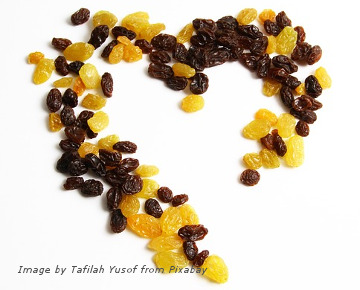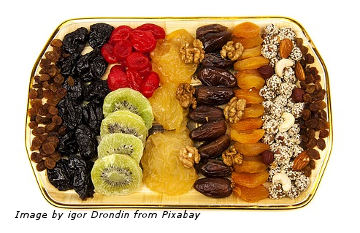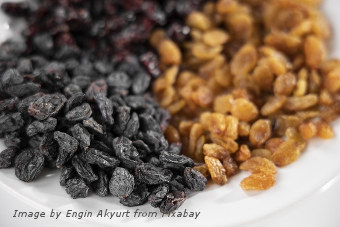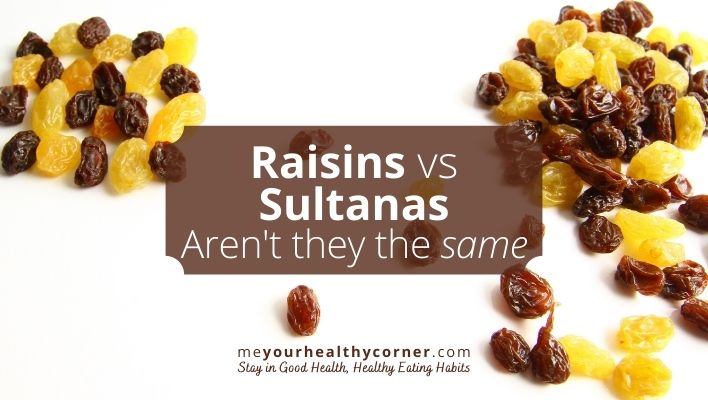I have known Ligo Raisins for 40 odd years (oops, now you know what age group I’m at) and it is one of my favourite snacks. Yesteryear, I used to buy boxes of Ligo raisins either at the school canteen or “Kedai” operated from a house in my neighbourhood. Now, there are many other brands of raisins and types too but what I really want to know is the difference between raisins and sultanas. You’re here reading this, which means you like to know too, don’t you? Let’s do this together and find some answers to related questions as well, such as their health benefits and how to include them in your daily diet. Read on…
Raisins vs Sultanas. Their Similarities & Differences
Generally, raisins and sultanas are categorized as dried fruit, and to be specific, they are dried grapes.
Both raisins and sultanas are highly nutritious and loaded with antioxidants and anti-inflammatory properties which you’ll read about further below.
So, what’s the difference between a raisin and sultana? The difference is mainly on the type of grapes they are made from and the processing method.
Raisins can be made from a range of grape varieties. They are typically dried naturally for about 3 weeks. Going through the drying process, the grapes darken. This explains the dark-coloured raisins.
How are sultanas made, then? Sultanas are only made from seedless green grapes. They are first coated in a vegetable oil solution which lessens the drying period to about 1 week. For this reason, they are lighter in colour than raisins. Additionally, they are preserved with sulfur dioxide to retain their lighter golden colour.

In the US, sultanas are called “golden raisins”.
Internationally, raisins and sultanas are named accordingly.
From where I’m at, Malaysia, the terms sultanas and golden raisins are used interchangeably. This leads to further confusion, aren’t raisins and sultanas the same? Thinking the only difference is the type of grape (red and green) used thus the colour. At least, this was what I thought. How about you?
You may have noticed sultanas are plumper than raisins. This makes them juicer and sweeter too. Sultanas tend to be smaller than raisins but there are these pulpy jumbo golden raisins (sultanas) you can buy online or at any hypermarkets and health store.
How about currants? I’ve seen this at the bakery ingredients shop and they look similar to raisins but much smaller. Currants are made of grapes too, the smallest varieties of grapes but the price is slightly more expensive. (just so you know)
Are Raisins and Sultanas Good for You
Raisins and sultanas are particularly good for your digestive health, and their antioxidant and anti-inflammatory properties can benefit your health in many ways. So are the minerals and vitamins content. The sugar content can be a concern but it is natural sugar, unlike refined sugar or processed which are bad for health.
Raisins vs Sultanas Nutrition Facts in Brief
Let’s compare the nutrients found in both raisins and sultanas based on a 1-ounce serving (28g) that’s about 60 raisins.
| Raisins | Sultanas | |
| Calories | 85 | 85 |
| Total Fats | 0.1g | 0.1g |
| Total Carbohydrates | 22g | 8% DV | 23g | 8% DV |
| Fibre | 1.3g | 5% DV | 0.9g | 3% DV |
| Sugar | 18g | 19g |
| Protein | 0.9g | 2% DV | 0.9g | 2% DV |
| Iron | 3% DV | 2% DV |
| Potassium | 4% DV | 4% DV |
| Copper | 9% DV | 7% DV |
| Phosphorus | 4% DV | 4% DV |
| Riboflavin | 3% DV | 4% DV |
| Vitamin B6 | 4% DV | 4% DV |
As you can see, the differences between the two are minimal. Both are good sources of carbohydrates and fibre. Also, contain a decent amount of copper, phosphorous, and potassium.
When grapes shrink during the drying process, they leave a compact, nutrient-dense dried fruit. So, by weight, dried grapes contain up to four times the fibre, vitamins, and minerals of fresh grapes.

How Do Raisins and Sultanas Benefit You
Since the nutritional profile of raisins and sultanas are very similar, you’ll benefit from them both. Let’s find out how.
Carbohydrates for Energy
Carbohydrates are your body’s main source of energy. They’re broken down into glucose (sugar) before being absorbed into your blood. Glucose is used by your body for energy. Protein and fats are sources of energy too but a balanced diet consisting of all 3 macronutrients, carbohydrates, protein, and fats give you well-rounded healthy meals.
I understand some people tend to stay away from carbs trying to slim down but one should not ditch carbs entirely.
Generally, there are two types of carbohydrates, simple and complex carbohydrates. Complex carbohydrates can be part of a healthy diet and they are mostly found in whole grains, fibre-rich fruits and vegetables, and beans.
In this case, raisins and sultanas make a good snack option giving you energy in between meals, especially before or after a workout routine.
A study on a group of cyclists found raisins to be a cost-effective source of carbohydrate for pre-exercise feeding in comparison to sports gel for short-term exercise bouts.
Fibre for Constipation & Weight Loss
Fibre helps improve your digestion by increasing the weight and size of your stool and softening them. Bulkier stools are much easier to pass and this helps prevent constipation.
Besides, fibre helps keep you fuller longer hence reduce your food cravings. Are you trying to lose some weight? Eating fibrous food helps. A handful of raisins, perhaps? But, how many raisins can you eat daily? Read on… answer below.
Antioxidants for Oxidative Stress & Inflammation
How are antioxidants, oxidative stress, and inflammation linked? Let’s start with oxidative stress.
Oxidative stress occurs when there is an imbalance of free radicals and antioxidants in your body.

Free radicals are molecules with one or unpaired electrons. The uneven number allows them to react with other molecules, stealing other cells of electrons. This can damage cells and cause a rise in many diseases including cancer and cardiovascular diseases.
While your body is able to maintain a balance between free radicals and antioxidants, several factors can cause an imbalance. They include diet, lifestyle, environmental factors such as pollution and radiation, and certain conditions.
Oxidative stress can cause chronic inflammation. It triggers your body’s inflammatory response, which, in turn, produces more free radicals and this leads to further oxidative stress, creating a cycle. Chronic inflammation is associated with many diseases such as arthritis, diabetes, and kidney diseases.
Antioxidants are substances that neutralize free radicals by donating an electron to the single-electron free radicals. This reduces them and protects your body from oxidative stress. Vitamins A, C, and E are examples of antioxidants and you can get them from fruits and vegetables.
On the whole, a diet rich in antioxidants benefits your overall well-being. Several studies found raisins contain phenolic antioxidants, which contribute to their potential health benefits (1, 2).
Minerals for Bone Health
No doubt calcium is the most important mineral for bone health, copper and potassium play their roles too.
Copper, together with others micronutrients such as magnesium, zinc, manganese, iron, and selenium have only recently been found to play an important role in bone health maintenance (1).
Potassium has a role too. A study showed dietary potassium intake was positively associated with bone mineral density in men aged above 50 years old and postmenopausal women, indicating the beneficial effects on bone health.
Raisins and sultanas have only a decent amount of copper and potassium but they are healthy options you can add to your diet for bone health.
Why are Raisins Bad for You? So are Sultanas
With the good comes the bad. While raisins and sultanas provide certain health benefits and help maintain your overall well-being, you need to know the bad they bring.
A single raisin contains the same amount of nutrients as a single grape. During the drying process, moisture is drawn but the nutrients remain though the loss is at a bare minimum. So is the sugar content.

Eating any dried fruits including dried cranberries, apricots, and dates, you can easily consume more than intended. This leads to eating too many calories or sugar. So, you need to be mindful when eating raisins or sultanas as a snack especially if you’re concern with blood sugar levels and weight control.
Although natural sugar from dried fruits is healthier than refined sugar, like any sugar, too much natural sugar from fruits isn’t good for you.
Another concern about eating too many raisins or sultanas is the increase of soluble fibre. Having too much fibre may cause stomach bloating, gas, stomach cramps, and diarrhoea. You should increase fluid intake and exercise more to reduce or prevent these from happening. When trying to increase your fibre intake, do so gradually for your body to adapt to the increase.
How Many Raisins Should You Eat Daily
Following the 5 A Day guideline, you only need 30g of dried fruits daily. This is equivalent to about one heaped tablespoon of dried fruits such as raisins, sultanas, and dried cranberries.
This one portion of 30g dried fruits is based on the weight of the fresh fruits. Hence, the nutrients and sugar content are similar. This ensures you do not overeat.
However, keep in mind each individual’s body and health conditions differ thus the 30g serving of dried fruits daily is just a guideline. Diabetics should take extra caution consuming dried fruits or avoid them altogether.
What is 5 A Day? 5 A Day is any of varied national campaigns in developed countries such as the United States, the United Kingdom, France, and Germany, to encourage the consumption of at least five portions of fruit and vegetables each day, following a recommendation by the World Health Organization.
What to Make with Raisins and Sultanas
Both raisins and sultanas can be used similarly in the kitchen. However, there is a reason why you should choose one over the other.
Raisins can soak up other flavours and hold on to them better than sultanas. This gives you a tastier finished dish or baked goods. For example, in Rum Fruit Cake where you soak the raisins together with other dried fruits in rum. Raisins absorb and retain the rum giving you a delectable mouthful. This is one of my favourite cakes and I make them every Christmas.
Although sultanas absorb flavours too, it is not as well as raisins because sultanas are plumper and juicer, not as dried as raisins. I normally add sultanas to my oatmeal, muesli, muffins, and scones.
So, to use raisins or sultanas, it depends on what you’ll be making. However, there is no golden rule you cannot use them interchangeably. If I run out of sultanas, I still use raisins.
Both raisins and sultanas are very versatile hence you can eat them as a snack or add them to salad and rice dishes besides the common baked goods and oatmeals. Many Indian dishes add raisins to curries.

Given their health benefits, wouldn’t you like to know more ways to incorporate them into your diet?
Here are some ideas
Morning oatmeal. Add raisins or sultanas to your oatmeal. They give you a natural sweetness and more texture to your otherwise bland morning oatmeal.
Morning/afternoon snack. Snack on raisins or sultanas but do not overdo it (remember the high sugar content?). Alternatively, build your own trail mix and add raisins into the mix. By doing so, you get a mix of nuts and seeds, which contain healthy fats and protein, with fewer dried fruits.
Lunch/Dinner. Add to the cheese platter. Grapes go very well with cheese and this does not mean you can’t do so with raisins or sultanas. Give it a try!
Add to salads. Give your salad a little sweetness. They pair well with bitter greens such as arugula, collard, and kale. For this, I would use sultanas. If you like to add more texture and nutrients to your salad, consider adding nuts and seeds such as walnuts, almonds, and pumpkin seeds too.
Add to savoury dishes. Try adding raisins or sultanas to rice dishes such as Mediterranean rice and Biryani rice. Couscous with raisins is another you should try. Other savoury dishes include meatballs and curries.
Any time of the day. Add to baked goods such as muffins, scones, and bread. I make my own bread almost every weekend for the week ahead and never fail to add sultanas together with seeds and chopped nuts. Besides the texture and taste, I’m fuller longer and seldom need a snack between meals.
In a Nutshell
Many of you would have assumed raisins and sultanas are the same, I included. It turns out not.

Although both can be used interchangeably, their processing methods and how they turned out determined which should be used in making certain food items.
Sultanas, juicier and plumper, make them ideal to be added to salads and baked goods and eaten as is. Raisins absorb and hold on to flavour better hence best used when cooking food with lots of liquid. Not forgetting to add raisins when soaking your overnight oats. That said, if you run out of raisins, simply substitute with sultanas or vice versa.
Raisins vs sultanas. Which is healthier? Both contain similar nutrients with only a slight variance in the amount. A good amount of fibre, carbohydrates, antioxidants, and minerals may benefit you in terms of bone and heart health, reducing oxidative stress and inflammation. The fibre content is particularly good for reducing constipation and weight control.
Though you need to remember too much fibre may have implications as mentioned above. Not forgetting the high sugar content.
As with any food, no matter how healthy they are, eating moderately is the key to good health.
Have you been eating too many raisins or sultanas? Do you eat them differently from what’s mentioned? Share with us in the comments section below. We’re also curious to find out if you know what the difference between a raisin and sultana is initially. Tell us!
Please share this article with anyone you think may find this information useful. Click the share button!
Learn more: Check out me Nuttylog for more nutty information
Here are a few related articles that may interest you.
Now, Let’s Get Started:
For US Shoppers, Shop on Amazon. There are plenty of choices you can choose from.
Take a look at what I found for you ↓

Delectable jumbo raisins – a mixture of California green, red, black, and golden raisins. Treated with less than 1% oil with sulfur dioxide added as a preservative.
Worth take a look on Amazon, if this is for you. 85% of customers gave 5-star comments vs 2% 1-star.
Happy shopping and thanks for reading.
Me YourHealthy Corner – Stay in Good Health, Healthy Eating Habits
Disclosure: This blog post contains affiliate links as part of the Amazon.com Services LLC Associate Programs and other affiliate services. This means that meyourhealthycorner.com receives a small commission by linking to amazon.com and other sites at no extra cost to the readers.
Medical Disclaimer: I am not a doctor or medical professional, and this post should not be taken as medical advice. Please do your own research. The material on this blog is provided for informational purposes only. It is general information that may not apply to you as an individual and is not a substitute for your own doctor’s medical care or advice.




I like both raisins and sultanas, but I prefer sultanas. Sultanas are sold more expensively in my area and they aren’t always available. Raisins are always offered in stores.
They do have a lot of nutrients as I can see in the chart. I didn’t know that they have iron as well, albeit a small percentage, but it’s there 🙂 which gives me more reason to buy them now. It’s good to know how many dried fruits one should eat daily, to avoid overeating them and ingesting too many sugars.
I also love the ideas on how to use raisins and sultanas. I recently put them in pancakes and it was a nice combination.
I understand iron deficiency may cause anemia which leaves one feeling tired and short of breath. Hence consuming iron-rich food is important. You may like to check out chia and flax seeds as they contain a good amount of iron.
I grew up in South Africa where we always had raisins and sultanas in the house. As snack food to take to school, my mum always made a mixture of peanuts, raisins and sultanas, which we all loved. It provided us with energy at break time, and being girls, my mum always said the iron is good for us as well.
Although I love both of them, I do not like it when it is used in cooking. I think it is the fact that they then go soggy, so the texture changes, that I don’t like. I’d rather eat them dry, or the grapes.
I get you, Line. I don’t like soggy food myself. If used in cooking a rice dish, I will add sultanas after the rice is cooked or before serving. Thanks for commenting and have a good day!